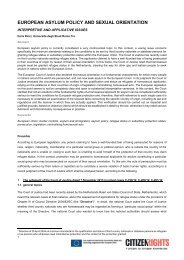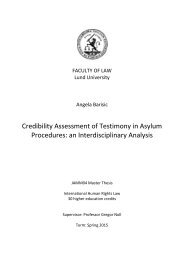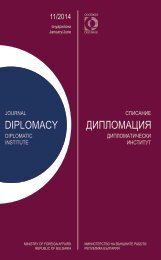AEMI
AEMI-2016-web
AEMI-2016-web
You also want an ePaper? Increase the reach of your titles
YUMPU automatically turns print PDFs into web optimized ePapers that Google loves.
FEDERICA MORETTI<br />
into a slightly different notion of geographic<br />
imaginary. This served the purpose<br />
of clarifying the imaginary’s role in<br />
place-constructing, whereby places are<br />
conceived as phenomenological spaces<br />
around and through which narratives<br />
and practices are developed. As far as the<br />
imaginary’s conception is concerned,<br />
Salazar’s definition proved particularly<br />
useful to grow my own understanding of<br />
the imaginary. In his own words imaginaries<br />
are ‘socially shared and transmitted<br />
(both within and between cultures)<br />
representational assemblages that interact<br />
with people’s personal imaginings<br />
and are used as meaning-making and<br />
world-shaping devices’ (Salazar, 2011b,<br />
p. 576). Likewise, I held utmost beneficial<br />
his reflections on the connection<br />
between imaginaries and (im)mobility. I<br />
especially shared the author’s suggestion<br />
that imaginaries have the ability to trigger<br />
people’s motion (ibid.). Evidently,<br />
this conception of imaginary overcomes<br />
the level of the mind, to foster practical<br />
consequences on the ways people<br />
(re)invent, (re)produce and (re)create<br />
places (Salazar, 2010 & 2011), and on<br />
the ways people relate to them.Bearing<br />
the above in mind, in this work I shall<br />
refer to the imaginary as a meta-empirical<br />
and dynamic concept.<br />
As far as the meta-empirical dimension<br />
of the notion is concerned, it suffices<br />
to note that far from being just a<br />
meta-world of intangible images, the<br />
imaginary influences the lives of the<br />
young people participating in the research.<br />
Then, imaginaries are dynamic because<br />
they are involved in a circular<br />
relationship with everyday empirical experiences.<br />
Essentially, they are protean<br />
185<br />
representational assemblages, through<br />
which people explore, escape, transform,<br />
expect, experience and make sense<br />
of the occurrences in their lives. They<br />
are, in this sense, dynamic.<br />
None of those features is overarching<br />
vis-à-vis the others. On the contrary,<br />
they are caught in a mutually-influencing<br />
tie, epitomizing a cause-effect<br />
circular relationship. Thus, the resulting<br />
portrait shall bear a multi-coloured<br />
livery, whereby every shade fades into<br />
the other, offering a vivid picture of the<br />
mind and the world lived by the individuals.<br />
Envisaging Italy: Between Wishes<br />
and Disenchantments<br />
Maybe I already adjusted to the stereotype<br />
that there is here. I think<br />
about the sun – but last time that I<br />
went to Italy it was Christmas, and<br />
there was no sun. Then the sea – but<br />
Modena has no sea. One follows the<br />
stereotype. (Marco)<br />
Envisaging is a complex phenomenon:<br />
rather than still-life drawing, minds<br />
shape images of reality that are compounds<br />
of synesthetic/unique conceptions.<br />
As a collage is composed by<br />
smaller tiles giving form to the final<br />
oeuvre, so is the imaginary of Italy. Not<br />
a homogenous, but a manifold picture<br />
emerges from the accounts, whereby intertwined<br />
bonds link the temporalities<br />
and the meta- empirical worlds. Postcards,<br />
family pictures, economic newscasts,<br />
socio-historical and culinary books<br />
are recalled in the stories, thus conjuring<br />
an image mentally and empirically lived<br />
by the Italian protagonists.<br />
In this paragraph, I shall disclose such









